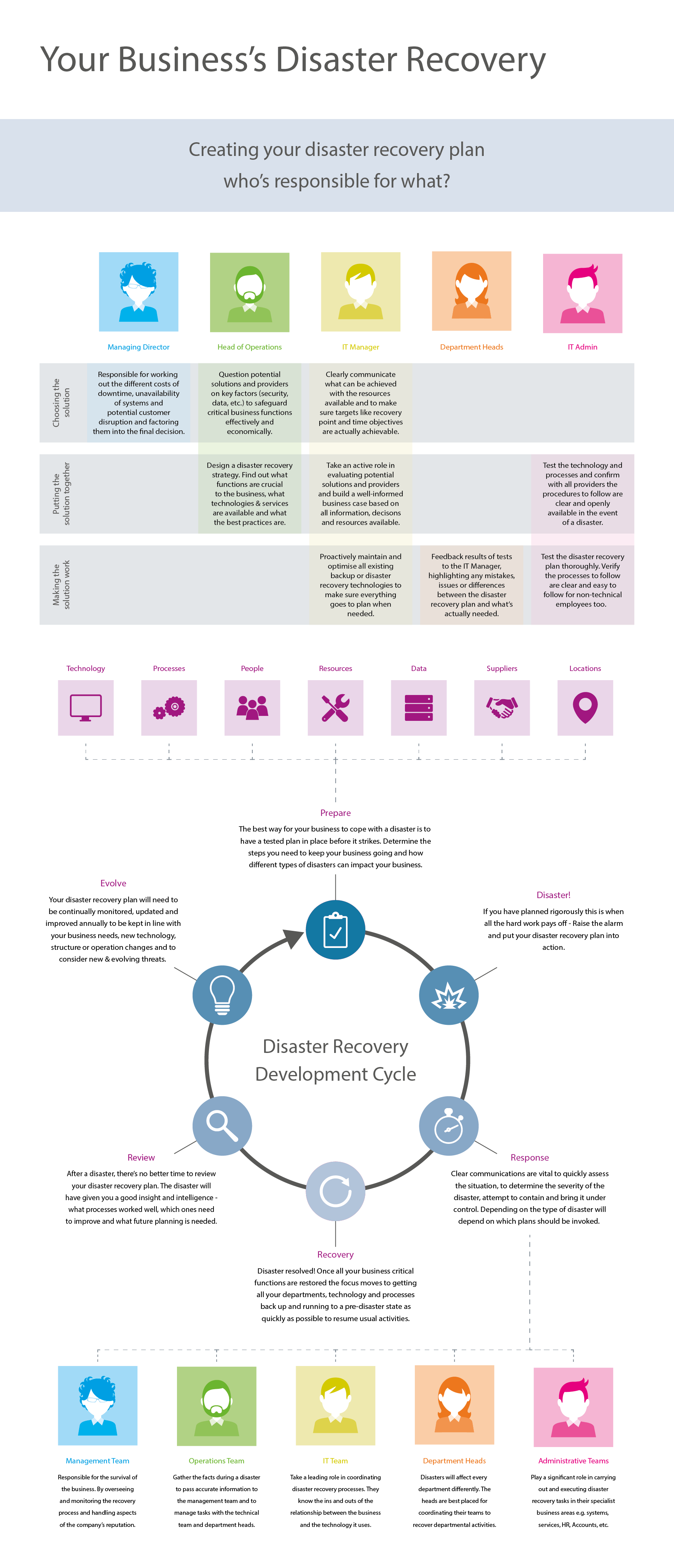
Creating your disaster recovery plan – who’s responsible for what?
Choosing the solution
- Managing Director – Responsible for working out the different costs of downtime, unavailability of systems and potential customer disruption and factoring them into the final decision.
- Head of Operations – Question potential solutions and providers on key factors (security, data, etc.) to safeguard critical business functions effectively and economically.
- IT Manager – Clearly communicate what can be achieved with the resources available and to make sure targets like recovery point and time objectives are actually achievable.
Putting the solution together
- Head of Operations – Design a disaster recovery strategy. Find out what functions are crucial to the business, what technologies & services are available and what the best practices are.
- IT Manager – Take an active role in evaluating potential solutions and providers and build a well-informed business case based on all information, decisions and resources available.
- IT Admin – Test the technology and processes and confirm with all providers the procedures to follow are clear and openly available in the event of a disaster.
Making the solution work
- IT Manager – Proactively maintain and optimise all existing backup or disaster recovery technologies to make sure everything goes to plan when needed.
- Department Heads – Feedback results of tests to the IT Manager, highlighting any mistakes, issues or differences between the disaster recovery plan and what’s actually needed.
- IT Admin – Test the disaster recovery plan thoroughly. Verify the processes to follow are clear and easy to follow for non-technical employees too.
Disaster Recovery Development Cycle
-
Prepare
The best way for your business to cope with a disaster is to have a tested plan in place before it strikes. Determine the steps you need to keep your business going and how different types of disasters can impact your business.
-
Disaster!
If you have planned rigorously this is when all the hard work pays off – Raise the alarm and put your disaster recovery plan into action.
-
Response
Clear communications are vital to quickly assess the situation, to determine the severity of the disaster, attempt to contain and bring it under control. Depending on the type of disaster will depend on which plans should be invoked.
- Managing Director – Responsible for the survival of the business. By overseeing and monitoring the recovery process and handling aspects of the company’s reputation.
- Head of Operations – Gather the facts during a disaster to pass accurate information to the management team and to manage tasks with the technical team and department heads.
- IT Manager – Take a leading role in coordinating disaster recovery processes. They know the ins and outs of the relationship between the business and the technology it uses.
- Department Heads – Disasters will affect every department differently. The heads are best placed for coordinating their teams to recover departmental activities.
- IT Admin – Play a significant role in carrying out and executing disaster recovery tasks in their specialist business areas e.g. systems, services, HR, Accounts, etc.
-
Recovery
Disaster resolved! Once all your business critical functions are restored the focus moves to getting all your departments, technology and processes back up and running to a pre-disaster state as quickly as possible to resume usual activities.
-
Review
After a disaster, there’s no better time to review your disaster recovery plan. The disaster will have given you a good insight and intelligence – what processes worked well, which ones need to improve and what future planning is needed.
-
Evolve
Your disaster recovery plan will need to be continually monitored, updated and improved annually to be kept in line with your business needs, new technology, structure or operation changes and to consider new & evolving threats.



